Kimchi Mandu is a special kind of Korean dumpling that has lots of Kimchi in the filling. It also is usually made quite big with so much filling that just eating a few of these will make you full and happy!

What is Kimchi Mandu
This North Korean style Kimchi Mandu is also called 이북식 만두 (Yibukshik Mandu) because Yibuk means ‘North Korea’. This dish is what I grew up eating and making at home. Sitting around our table in the kitchen, our family made mandu – probably as many as a hundred especially when it was near Korean New Year’s (설날 Seollal).
Because my grandmother lived with us, we had a lot of relatives visit our home for Seollal. And in those days, guests were ALWAYS fed Tteok mandu guk (떡만두국) no matter what time of day it was. 🙂
This Mandu is also sometimes called – 평양만두 (Pyeongyang mandu) where Pyeongyang is the capital of North Korea, and this mandu originally comes from that area. It can also go by 왕만두 (wang mandu) – ‘wang’ means king in Korean and it means it’s a king-size mandu.
If you’re more interested in a fried version of Korean mandu with glass noodles in the filling, check out my Gun Mandu / Yaki Mandu recipe! It offers a crispier alternative. 😋
With the Korean New Year holiday (설날 Seollal) around the corner, I have a craving for homemade North Korean-style kimchi mandu (dumplings). And I don’t mean just semi-home-made dumplings that use ready-made, store-bought mandu wrappers… I wanted to eat the ones that were made with homemade dough.
Once you have tasted these, you will want to have them again and again… I am sad that these days, very few Koreans make mandu at home like our parents used to when I was little. So.. although my post will be long, I hope you will bear with me and hope that some of you will even find time to make them at home while enjoying the slow process.
The recipe I introduce here uses a combination of pork and beef. You can adjust the amount of the meat (all beef, all pork, etc) and kimchi to your taste.
How to make VEGAN KIMCHI DUMPLINGS
To make a vegan kimchi dumpling, omit meat and substitute with more tofu (4 oz additional) and add 4 oz chopped shitake mushrooms and it will still be delicious!
Mandu Recipe for Korean Kimchi Mandu (Dumplings)
Servings: 18×4 inch mandu Prep Time: 2 hrs Cooking Time: 15 min Difficulty: Medium to High
Ingredients
- 4 oz or 1 C ground beef
- 4 oz or 1 C ground pork
- seasoning for meat
- 1 tsp dark soy sauce (진간장 jinkanjang)
- 1 tsp chopped garlic
- 1 tsp chopped ginger or ½ tsp ginger powder
- 1/4 tsp sea salt
- black pepper
- 1/2 C to 1 cup chopped cabbage kimchi
- 4 oz bean sprouts (roughly 1/2 package of 8 oz bags)
- 1/2 tsp sesame oil + 1/8 tsp salt
- 8 oz extra firm tofu (usually 1/2 Korean tofu package
- 1/2 tsp sesame oil + 1/4 tsp salt
- 1 bunch Korean chives (부추 buchu) or green onions
- Wrapper Dough (만두피 mandu pea)
- 3 C all-purpose flour (use bread flour for more chewy skin)
- 1 T vegetable oil
- ¾ C + 1~2 T water
MAKE THE DOUGH
- Make the dough by mixing 3 C flour, 2 tsp salt, 3/4 C water, and 1 T vegetable oil. Add 1~ 2 T water depending on how your dough comes out. Knead for a few minutes until the dough looks even throughout. It should not be so wet that it sticks to your hands but not so dry that you see dry spots in the dough. It should look something like this –

Keep the dough covered with a wet towel and let it sit for 30 min to 1 hour.
MAKE STUFFING
- Start boiling 4 C of water to cook the sprouts.
- Rinse bean sprouts and cook in boiling water. When the water comes back to a boil after adding the sprouts, turn off the heat. Drain and rinse sprouts in cold water to stop it from cooking further.

Take a handful of cooked sprouts and gently remove excess water by squeezing them into a ball. No need to squeeze too hard— just enough so that they look something like this.

Rough chop cooked sprouts into 1/2 in long pieces.
Season chopped sprouts with 1/2 tsp sesame oil and 1/8 tsp salt.
Chop cabbage kimchi. If you’re using 포기김치 (Pogi kimchi), remove extra seasoning (양념 Yangnyeom) from the cabbage to make it less spicy and salty. You can even rinse the kimchi in water if you want a milder taste.

Combine both ground meats and season altogether with 1 tsp each of soy sauce, chopped garlic, and ginger. Add 1/4 tsp salt and a few dashes of pepper. Mix well.
For tofu, use a cheese cloth to squeeze excess water. This is BEFORE

and AFTER

Season tofu crumbles with 1/2 tsp sesame oil and 1/4 tsp salt.
Chop a handful of Korean chives like so.

Mix meat, bean sprouts, kimchi, tofu and chives altogether.

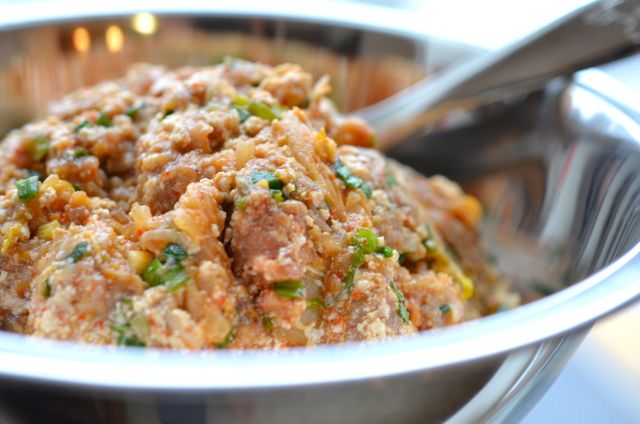
How to make Korean Dumpling (Mandu) wrappers
- Divide and shape the dough into walnut size (1.5-inch) balls.

Roll out each piece of dough to about 4 in. rounds. I did not have a rolling pin so I used a glass bottle which is exactly what my mom used. And it worked just fine!
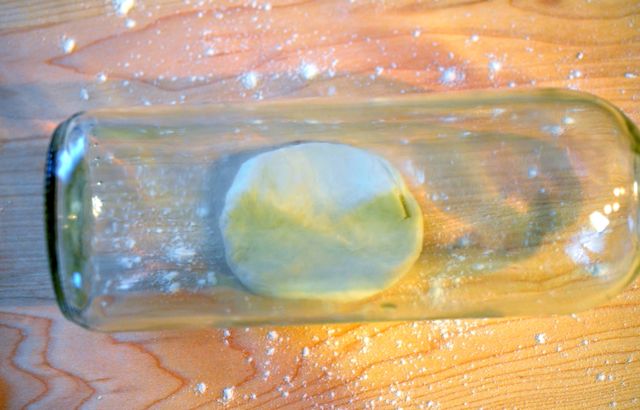
Here’s a comparison picture of my home made mandu wrapper on the left and a store-bought one on the right.

Can’t you just taste the difference from looking at it? I think I can!! Haha
Now, we are finally ready to put it all together!!! Take the wrapper and put it on your palm.
Then, take about 2 heaping spoonfuls of the stuffing and put it at the center of the wrapper. The amount of stuffing should feel like it’s too much for the wrapper.

Start sealing the dumpling by pinching the center edges. Since you are making dumplings with fresh dough, there’s no need to use water or egg whites to help the edges seal tight.

Seal off the rest by pinching the remaining sides.

Here is how it looks when dumpling is all closed up!

Sprinkle flour on a tray and lay them on it, without touching each other.

It is time to COOK!!!
You can either cook it in boiling water for 10-15 minutes, until it floats to the top, steam it in a steamer for 10-15 min, or add it to a beef broth for Manduguk (Korean Dumpling Soup). I think boiled dumplings maintain the chewiness of the wrapper skin the best without the edges drying out, which can happen with steaming sometimes.

By the way, if you are wondering how I added the pleated designs into the mandu— here’s how! Just fold the edge once like this, and repeat every couple of centimeters, or 1/2 inch.

** Updated some salt amounts on 12/30/2020
FROM JINJOO!
Tips for storage
- While the rice is cooking, keep smelling the pot to avoid the rice from burning. Adjust fire if you think it’s burning. Try NOT to open the pot while it is cooking. Korean short grain rice are different from long grain rice and don’t do well when you open the pot while it’s cooking.
- You may think the yangnyeom jang sauce is pretty bland for Korean standards but this is how Korean Temple food is. It really tries to bring out the natural flavors of the ingredients which are mushrooms in this case. So do not make the sauce too strong/spicy because it will overpower the mushroom flavor.
- You can use regular sesame oil instead of perilla seed oil. It will be less aromatic but perilla seed oil has a flavor that not everyone likes and is also not easy to get in most countries so sesame oil should work fine.
- You are welcome to use other kinds of mushrooms, but try to use a variety of flavors and textures.
- An electric rice cooker can make your life much easier but you will probably not get the same wonderful flavor.
My favorite Kimchi Dumplings restaurants in seoul
Finally, some restaurant recommendations that serve this kind of Korean dumpling in Seoul – Pildong Myeonok (필동면옥) in Pildong and Jinnampo Myeonok (진남포면옥) in 약수동 are my favorites. These restaurants have been around for generations, started by owners who are originally from North Korea, much like my parents.
A special thank you to my sis #2 for letting me use her kitchen and dishes for this post !! 💕
ENJOY!
XOXO ❤️
JinJoo
Here’s a new YouTube video showing how to make Kimchi Mandu at home!
Mandu – Korean Dumplings
Ingredients
- 4 oz ground beef
- 4 oz ground pork
seasoning for meat
- 1 tsp dark soy sauce (진간장 Jinganjang)
- 1 tsp chopped garlic
- 1 tsp chopped fresh ginger
- 1/4 tsp Sea Salt (Trader Joe’s)
- black pepper
Stuffing Ingredients
- 1/2 C chopped cabbage Kimchi add more if you love Kimchi, up to double amount
- 4 oz bean sprouts 4 oz = roughly 1/2 package
- 1/2 tsp sesame oil (for seasoning bean sprouts)
- 1/8 tsp salt (for seasoning bean sprouts)
- 8 oz extra firm tofu 8 oz = 1/2 Korean tofu pack
- 1/2 tsp sesame oil (for seasoning tofu)
- 1/4 tsp salt (for seasoning tofu)
- 1 bunch Korean chives (부추 Buchu or green onions)
Wrapper Dough (만두피 Mandu Pea)
- 3 C all purpose flour (use bread flour for more chewy skin)
- 1 Tbsp vegetable oil
- ¾ C water (plus 1 to 2 Tbsp water as needed)
- 2 tsp fine sea salt
Instructions
Make Dumpling Wrapper Dough OR use store-bought
- Make dough by mixing 3 C flour, 2 tsp salt, 3/4 C water and 1 T vegetable oil. Add 1~ 2 T water depending on how your dough comes out. Knead for few minutes until the dough looks even throughout. It should not be so wet that it sticks to your hands but not so dry that you see dry spots in the dough. Keep dough covered with a wet towel and let it sit for 30 min to 1 hour.

Make Stuffing
- Start boiling 4 C of water to cook sprouts in (for 4 oz)
- Rinse bean sprouts and cook in boiling water. When water comes back to boil after adding the sprouts, turn off heat. Drain and rinse sprouts in cold water to stop it from cooking further.

- Take a handful of cooked sprouts and gently remove excess water by squeezing them into a ball.
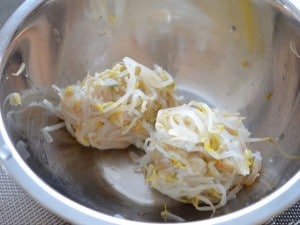
- Rough chop cooked sprouts into 1/2 in long pieces.
- Season chopped sprouts with sesame oil and salt.
- Chop cabbage Kimchi.

- Season ground pork and beef altogether with soy sauce, chopped garlic, ginger. Add salt and few dashes of pepper. Mix well.
- For tofu, use a cheese cloth to squeeze excess water.

- This is how tofu looks after it's squeezed – broken into crumbles.
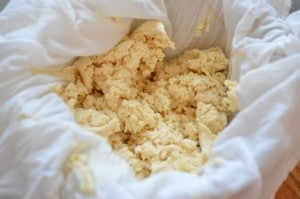
- Season tofu crumbles with sesame oil and salt.
- Chop a handful of Korean chives.

- Mix meat, bean sprouts, kimchi, tofu and chives altogether. Set aside to use as stuffing.

- Fully mixed stuffing ->

How to make Korean dumpling wrappers
- Divide and shape dough into walnut size (1.5 inch) balls.

- Roll out each piece of dough to about 4 in rounds. I did not have a rolling pin so I used a glass bottle which is exactly what my mom used. And it worked just fine!

Stuff Dumpling
- Now, we are finally ready to put it all together!!! Take the wrapper and put it on your palm. And then take a spoonful of stuffing and put it at the center of the wrapper. The amount of stuffing should feel like it's too much for the wrapper.

- Start sealing the dumpling by pinching the center edges. Since you are making with fresh dough, there’s no need to use water or egg whites to help the edges seal.

- Seal off the rest by pinching remaining sides.

- Here's how it looks after it's done
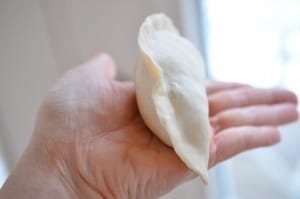
- Sprinkle flour on a tray and lay them out without letting them touch each other.

- Time to COOK!!! You can either cook it in boiling water for 10-15 min until it floats to the top, steam it in a steamer for 10-15 min, or add it to a beef broth to make Manduguk (Korean Dumpling Soup).
Tips & Notes:
- You can freeze uncooked dumplings for later. The trick is to first freeze the dumplings briefly uncovered on a tray (see pic in step 8) until they feel hard on the outside.
- Once the outside is frozen hard, you can then put them all together in a freezer bag and freeze them for later use.





















This is a great recipe. I put in bean thread noodles instead of sprouts and halved the amount of tofu, per personal preference. But the seasoning ratio was perfect!
Awesome!! Sure, noodles work great too. Thank you for the 5 stars! Enjoy!
I’m salivating looking at the photo..and will try this recipe on weekend.. BTW, I like the texture of gyoza (Japanese dumpling)..would this be still ok if I steam fry it just like gyoza to get the crust on the outer skin?
Hi Devi, sure you can steam fry to get the crust. And because you will be making the dough, it should come out nice and thick like gyoza. Good luck and enjoy!
Could i substitute the beef and pork to chicken ? And what’s the difference between korean tofu and silk tofu ? Or are they the same
Yes, you can substitute chicken. The difference is not that they are Korean or not, it is the firmness that matters and what you need for dumplings is EXTRA FIRM tofu. Silk tofu is too soft and silky. 🙂 You can learn all about tofu in my https://kimchimari.com/easy-tofu-recipe-broccoli-dubu-muchim/ post. Thanks for asking!
Hi! One of the things I miss the most is Mandu since being diagnosed celiac. Do you have any recipe suggestions or know of any pre-prepared GF brands of mandu? I always check my korean grocery store without success. Thanks!
Hi! Sure, I know it’s not easy to find gluten free mandu. I have actually not tried to make gluten free manu wrapper myself ( I should huh..?) but I’m thinking that you could use gluten free flour for bread and start from there. Cup4Cup makes great gluten free flour that you can usually substitute cup for cup in any recipe. So I would try getting Cup4Cup flour for pizza or bread and then try making wrapper with that. For pre-prepared mandu, Pulmuone is always my preferred brand and they do have a couple mandu that is GF. has rice+sweet rice flour wrappers or sweet rice+potato flour wrapper mandu. There’s pulmuone 방울만두 that has sweet rice+potato flour wrapper (0% flour) and there’s 쌀물만두 that may be GF. Problem is, these may only be available in Korea and not in US. Not sure where you live though…I will have to try making some GF dough and post. Another idea I’m thinking is that try searching for shumai recipes – their wrapper dough is usually made with rice flour I think. You could use my kimchi dumpling stuffing and use that wrapper dough. Good luck!!! And please check back every now and then because I may have a GF dough recipe up on my blog.
I’ve tried it! i am from malaysia and a muslim so i didn’t used any pork or non-halal ingredient but it still tastes sooooo good. i even made my own mandu wrappers just like you did and compared to the ones that i bought at the store, the taste was completely different (the homemade one was better obviously!). i like to eat them both ways (fried and steamed). i especially love korean foods since i always watched korean dramas/variety shows, and got drooled over the foods they’ve eaten on the show hahaha! eventhough i can just go to any korean restaurants to eat everything but since i love cooking at home so why not right! to be honest i just discovered your blog today and tell you what, i love it! i love your blog! oh dear i’m way too excited right now so this better be the last sentence hahaha greetings from malaysia! 🙂
Oh Great!! And you don’t need pork – it will taste good with just tofu and kimchi. So glad you made your own wrappers – don’t the make a HUGE difference?? Thanks SO much for commenting – really makes me happy. Have a great weekend! Sorry for the late reply – been busy cooking for a contest. 😉